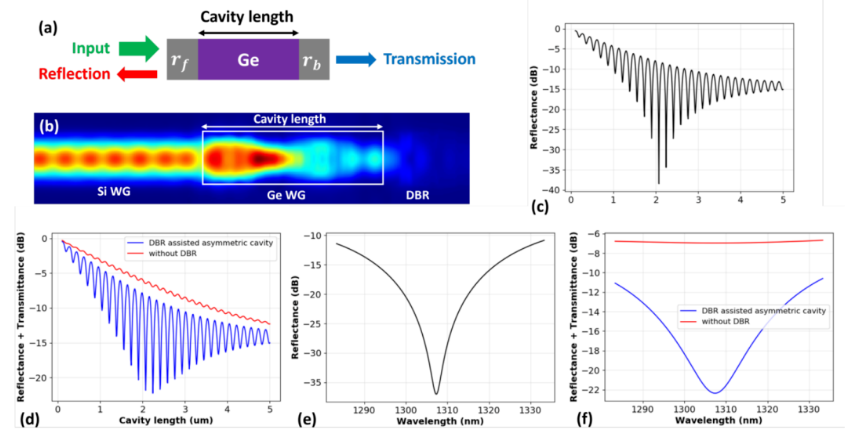Today let’s take a look at OFC2024 photodetectors, which mainly include GeSi PD/APD, InP SOA-PD, and UTC-PD.
1. UCDAVIS realizes a weak resonant 1315.5nm non-symmetric Fabry-Perot photodetector with very small capacitance, estimated to be 0.08fF. When the bias is -1V (-2V), the dark current is 0.72 nA (3.40 nA), and the response rate is 0.93a /W (0.96a /W). The saturated optical power is 2 mW (3 mW). It can support 38 GHz high-speed data experiments.
The following diagram shows the structure of the AFP PD, which consists of a waveguide coupled Ge-on-Si photodetector with a front SOI-Ge waveguide that achieves > 90% mode matching coupling with a reflectivity of <10%. The rear is a distributed Bragg reflector (DBR) with a reflectivity of >95%. Through the optimized cavity design (round-trip phase matching condition), the reflection and transmission of the AFP resonator can be eliminated, resulting in the absorption of the Ge detector to nearly 100%. Over the entire 20nm bandwidth of the central wavelength, R+T <2% (-17 dB). The Ge width is 0.6µm and the capacitance is estimated to be 0.08fF.


2, Huazhong University of Science and Technology produced a silicon germanium avalanche photodiode, bandwidth >67 GHz, gain >6.6. The SACM APD photodetector structure of transverse p-i-p-i-n junction is fabricated on a silicon optical platform. Intrinsic germanium (i-Ge) and intrinsic silicon (i-Si) serve as the light absorbing layer and electron doubling layer, respectively. The i-Ge region with a length of 14µm guarantees adequate light absorption at 1550nm. The small i-Ge and i-Si regions are conducive to increasing the photocurrent density and expanding the bandwidth under high bias voltage. The APD eye map was measured at -10.6 V. With an input optical power of -14 dBm, the eye map of the 50 Gb/s and 64 Gb/s OOK signals is shown below, and the measured SNR is 17.8 and 13.2 dB, respectively.
3. IHP 8-inch BiCMOS pilot line facilities shows a germanium PD photodetector with fin width of about 100 nm, which can generate the highest electric field and the shortest photocarrier drift time. Ge PD has OE bandwidth of 265 GHz@2V@ 1.0mA DC photocurrent. The process flow is shown below. The biggest feature is that the traditional SI mixed ion implantation is abandoned, and the growth etching scheme is adopted to avoid the influence of ion implantation on germanium. The dark current is 100nA,R = 0.45A /W.
4, HHI showcases InP SOA-PD, consisting of SSC, MQW-SOA and high speed photodetector. For the O-band. PD has A responsiveness of 0.57 A/W with less than 1 dB PDL, while SOA-PD has a responsiveness of 24 A/W with less than 1 dB PDL. The bandwidth of the two is ~60GHz, and the difference of 1 GHz can be attributed to the resonance frequency of the SOA. No pattern effect was seen in the actual eye image. The SOA-PD reduces the required optical power by about 13 dB at 56 GBaud.
5. ETH implements Type II improved GaInAsSb/InP UTC-PD, with a bandwidth of 60GHz@ zero bias and a high output power of -11 DBM at 100GHz. Continuation of the previous results, using GaInAsSb’s enhanced electron transport capabilities. In this paper, the optimized absorption layers include a heavily doped GaInAsSb of 100 nm and an undoped GaInAsSb of 20 nm. The NID layer helps to improve the overall responsiveness and also helps to reduce the overall capacitance of the device and improve the bandwidth. The 64µm2 UTC-PD has a zero-bias bandwidth of 60 GHz, an output power of -11 dBm at 100 GHz, and a saturation current of 5.5 mA. At a reverse bias of 3 V, the bandwidth increases to 110 GHz.
6. Innolight established the frequency response model of germanium silicon photodetector on the basis of fully considering device doping, electric field distribution and photo-generated carrier transfer time. Due to the need for large input power and high bandwidth in many applications, large optical power input will cause a decrease in bandwidth, the best practice is to reduce the carrier concentration in germanium by structural design.
7, Tsinghua University designed three types of UTC-PD, (1) 100GHz bandwidth double drift layer (DDL) structure with high saturation power UTC-PD, (2) 100GHz bandwidth double drift layer (DCL) structure with high responsiveness UTC-PD, (3) 230 GHZ bandwidth MUTC-PD with high saturation power, For different application scenarios, high saturation power, high bandwidth and high responsiveness may be useful in the future when entering 200G era.
Post time: Aug-19-2024





